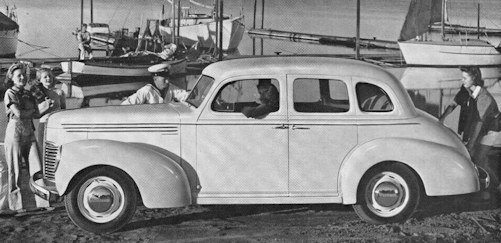Studebaker Champion First generation
 |
|
|
Production |
1939–1941 |
|
Class |
Motor car |
|
Body style |
2-4 door sedan |
|
Engine |
164.3 cu in (2.7 L) I6 |
|
Length |
188.75 in (4,794 mm) |
The Studebaker Champion was a car provided by the Studebaker in South Bend (Indiana) . The production of this model began with the model year 1939 and was continued until 1958 when it was discontinued in favor of the successor Lark . Previously, Studebaker had to sign a comparison and was eager to make the production profitable again.
The success of the champion in the model year 1939 Studebaker needed after the weak sales figures of the previous year urgently to survive.
Like few other car models, the Champion was designed on a "white paper", meaning that there was no need to re-use older parts or later use the newly designed components in larger cars. Thorough market observations led to a specification , but the crucial design principle was the premise "The weight is the enemy!". For his size, the champion was the lightest car of his time; his biggest competitor in this regard was the Willys Americar which, however, was not subjected to such a deliberate design process. And the result was impressive: its ram-controlled engine was retained until the abandonment of automobile production in 1961 (albeit with a modified valve train as OHV ).The 164.3 cu in (2.7 L) I6 engine produced 78 horsepower (58 kW; 79 PS). In 1940, Studebaker claimed 27.25 mpg‑US (8.63 L/100 km; 32.73 mpg‑imp).
The champion was one of Studebaker's biggest sales successes due to its low price (only $ 660 for the 1939 business coupe), durable engine and styling. Styling was done by industrial designer Raymond Loewy , whom Studebaker had commissioned to design their models.
The Champion was introduced in 1939. , the grille and headlights were partially integrated Following the design trends of the time. Deluxe models came with arm rests and dual wipers. The last first generation in 1941, the bodies were given a more streamlined look with a wider, lower grille.
Manuals
-
Studebaker Previous 6 / 25 Next
